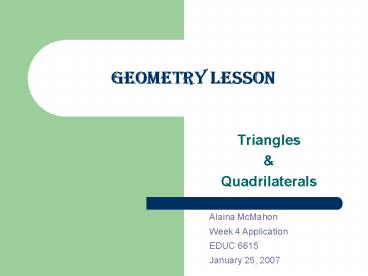Geometry Lesson PowerPoint PPT Presentation
1 / 15
Title: Geometry Lesson
1
Geometry Lesson
- Triangles
- Quadrilaterals
Alaina McMahon Week 4 Application EDUC
6615 January 25, 2007
2
Visual Representation of My Lesson
- I understand that not all people are familiar
with Geometry, and I wanted to make sure that
anyone who looks at this presentation would have
a better insight of my lesson. The next few
slides are actual parts of my lesson on triangles
and quadrilaterals. I taught this lesson on my
SMART Board, which allows me to be more creative
in how I teach mathematics.
3
(No Transcript)
4
(No Transcript)
5
What characteristics do you have in order to be
accepted in each club?
6
Multiple Intelligences Employed
- Verbal-Linguistic
- Students listened to me as I gave my lecture.
- Students discussed answers with peers and myself.
- Logical-Mathematical
- Students compared the different triangles and
quadrilaterals. - Students had to reason why the characteristics of
the triangles and quadrilaterals overlap. - Students had to take notes during the lesson.
7
Multiple Intelligences Employed
- Spatial
- Students had to understand the relationship chart
and Venn diagram for quadrilaterals. - Students had to use their abilities to visualize
the polygons in their minds. - Students had to follow a very visual presentation
of notes. - Students were exposed to a variety of colors and
shapes.
8
Multiple Intelligences Employed
- Bodily-Kinesthetic
- Students had to get up and role play how the Venn
diagram works by explaining the Quadrilateral
Club. - Interpersonal
- Students and I discussed the relationships of
different triangles and quadrilaterals. - After completing a problem on their own students
compared their answers with their peers. - I used a lot of body language and voice
inflections to explain the Quadrilateral Club. - Intrapersonal
- Students worked on problems on their own.
9
Learning Styles Employed
- Mastery Learner (ST)
- Students learned through my demonstrations of how
quadrilaterals are related. - Students used their inclination for remembering
and describing the different triangles and
quadrilaterals. - Interpersonal (SF)
- Students where able to role play with one another
when explaining the qualifications to get into
the different Quadrilateral Clubs. - Understanding (NT)
- Students had to listen intently from my lecture.
- Students used their inclination for analyzing and
connecting the relationships of triangles and
quadrilaterals. - Self-Expressive (NF)
- Students had to contemplate why the different
triangles and quadrilaterals have characteristics
that overlap.
10
Principles of Diversity
- Principle 1 Comfort
- As Silver, Strong, and Perini (2000) stated, It
is important to create comfort by employing
learning activities in each of the four style
neighborhoods and in a wide range of
intelligences (p. 44). - As you can see from earlier slides I did hit
three out of the four learning styles and six out
of the eight intelligences. - This lesson was indeed a lesson for all types of
learners, which produced a high comfort level for
my students.
11
Principles of Diversity
- Principle 2 Challenge
- Students are challenged to think beyond the
basics of a triangle, square, and rectangle. - Students must be able to list and describe all of
the characteristics of the different triangles
and quadrilaterals. - Triangles - equilateral, isosceles, scalene,
acute, obtuse,
and right - Quadrilaterals parallelogram, rectangle,
square, rhombus, and
trapezoid - Students must understand how and why the
characteristics overlap.
12
Principles of Diversity
- Principle 3 Depth
- Students were required to use higher thinking to
answer questions, which ensured their
understanding of the material. - For example A square is a rectangle.
- (Never, Sometimes, or Always)
- A triangle is a quadrilateral.
- (Never, Sometimes, or Always)
- Deeper thinking and thinking out of the box must
take place to answer these questions.
13
Principles of Diversity
- Principle 4 Motivation
- Students were motivated through the fun of role
playing. - It was not the traditional lecture for 42
minutes. - Students were enthralled in my ability to animate
the lesson with my energetic body language and my
personal excitement for the lesson.
14
Summary
- In the past when I taught this lesson on
triangles and quadrilaterals I was never aware
that I was hitting the different learning styles
and intelligences. I personally thought I was
just being creative in how I was teaching the
lesson. Today I am more in tuned with my
students individual learning needs. I take
larger strides to make sure I am reaching all of
my students on their level of learning. I am more
focused on being a teacher with an open mind to
diversity from my normal routines. If I make sure
that I am paying attention to the four key
principals of comfort, challenge, depth, and
motivation, I am sure I will reach the maximum
achievement of using these two models of
learning.
15
References
- Silver, H. F., Strong, R. W., Perini, M. J.
(2000). So each may learn Integrating learning
styles and multiple intelligences. Alexandria,
VA Association for Supervision and Curriculum
Development.

